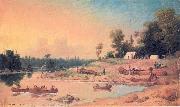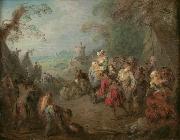
|
Paul Kane
|
|||
|
|
|||
| (September 3, 1810 - February 20, 1871) was an Irish-born Canadian painter, famous for his paintings of First Nations peoples in the Canadian West and other Native Americans in the Oregon Country. A largely self-educated artist, Kane grew up in Toronto (then known as York) and trained himself by copying European masters on a study trip through Europe. He undertook two voyages through the wild Canadian northwest in 1845 and from 1846 to 1848. The first trip took him from Toronto to Sault Ste. Marie and back. Having secured the support of the Hudson's Bay Company, he set out on a second, much longer voyage from Toronto across the Rocky Mountains to Fort Vancouver and Fort Victoria in the Columbia District, as the Canadians called the Oregon Country. | |||
|
|
|||
|
Encampment new24/Paul Kane-495733.jpg Måleriet identifieringen:: 73971 |
Date June 10, 1846 Medium Oil on paper Dimensions 20.6 X 34 cm (8.11 X 13.39 in) cyf | ||
|
|
|||
|
Jean-Baptiste Pater
|
|||
|
|
|||
| Jean-Baptiste Pater (December 29, 1695 - July 25, 1736) was a French rococo painter. Born in Valenciennes, Pater was the son of sculptor Antoine Pater and studied under him before becoming a student of painter Jean-Baptiste Guide. Pater then moved to Paris, briefly becoming a pupil of Antoine Watteau in 1713. Watteau, despite treating Pater badly, had a significant influence on him. However the two quarreled and Pater returned to Valenciennes, where he remained for two years. In 1721, Pater and the dying Watteau reconciled; subsequently Pater became a student of Watteau once again, although only for a month before the latter's death. Pater later claimed to have learnt everything he knew during those few weeks with Watteau. He was accepted into the Academie in 1728, presenting a large military work in the popular Watteau style - La Rejouissance des Soldats (Louvre).[1] Pater adopted the popular Fete galante subject matter, heavily imitating his teacher Watteau, indeed he directly copied some of his figures. Pater used a traditional Rococo pastel palette. His most characteristic difference in style from other artists of the time surrounded his use of shimmering lines. His most prominent customer was Frederick the Great, who sat for two portraits in the "Turquerie" style: LeSultan au Harem and Le Sultan au Jardin. One of Pater's most renowned works is Landscape with a Cart (Schloss Charlottenburg), which is considered to display a feathery application of paint that anticipates Francesco Guardi. The delicately constructed subject matter and figures subordination to the buildings represent a movement away from fete galante, however this development was cut short by Pater's death in 1736. | |||
|
|
|||
|
Encampment new25/Jean-Baptiste Pater-449837.jpg Måleriet identifieringen:: 90485 |
oil on canvas Dimensions 17 x 22 cm (6.7 x 8.7 in) cyf | ||
|
|
|||
|
Also Buy::. For Following Paintings / Artists / Products, Please Use Our Search Online: |







